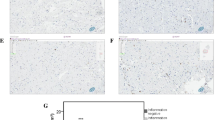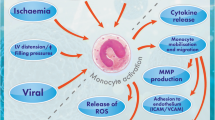Abstract
Programmed myocyte cell death and activation of the immune system have been shown to occur in patients with congestive heart failure. Besides, unstable angina episodes are likely to be associated with immune activation. Our aim was to evaluate the role of changes in circulating levels of soluble Fas (sFas), suggestive of an enhanced inhibitory response to ongoing apoptosis, and soluble IL2 receptor (sIL2-R), indicative of T-lymphocyte activation, in chronic heart failure and unstable angina pectoris. Thirty patients affected by chronic heart failure (20 idiopathic and 10 ischemic cardiomyopathy) and 13 patients with unstable angina were evaluated. Twenty healthy individuals matched for age and gender were used as controls. A complete biochemical determination of indexes of myocardial damage including cardiac troponin I (cTnI) and creatine kinase (MB/CK) was performed. The results demonstrated that mean levels of sFas and sIL2-R were significantly increased in patients affected by chronic heart failure and unstable angina and were not associated with changes in renal function or with serum levels of cTnI. Highest values of sFas were found in NYHA class IV patients (IV NYHA class = 7.39 ± 0.52 vs. controls = 1.34 ± 0.12 ng/ml; P < 0.01) and more elevated in idiopathic than in ischemic cardiomyopathy (3.64 ± 0.40 vs. 1.82 ± 0.37 ng/ml; P < 0.01). Moreover, in chronic heart failure patients sFas and ejection fraction were negatively correlated (P = 0.01), whereas sFas and sIL2-R were positively correlated (P < 0.01). In unstable angina patients too, sFas and sIL2-R appeared to be correlated (P = 0.03); whereas sFas (angina group = 3.18 ± 0.39 vs. controls = 1.34 ± 0.12 ng/ml; P < 0.01) and sIL2-R (angina group = 0.46 ± 0.11 vs. controls = 0.00 UI/ml; P < 0.01) were higher in angina group than in controls. In most of the cases, the increase of sFas was associated with comparable changes in sIL2-R serum levels, indicating that the activation of Fas system is strictly associated with autoimmune–inflammatory reactions. This phenomenon, both in chronic heart failure and in unstable angina, occurs in the absence of biochemical evidences of myocardial damage and seems to parallel the activation of T cell. Soluble Fas could have a role in sustaining inflammatory response and in prolonging the detrimental effects correlated with it in chronic heart failure and angina pectoris.
Similar content being viewed by others
REFERENCES
Olivetti G, Abbi R, Quaini F, Kajstura J, Cheng W, Nitahara JA, Quaini E, Di Loreto C, Beltrami CA, Krajewski S, Reed JC, Anversa P: Apoptosis in the failing human hearts. N Engl J Med 336:1131-1141, 1997
Chen C, Lijie MA, Linfert DR, Tianjie L, Fallon JT, Gillam LD, Waters DD, Tsongalis GJ: Myocardial cell death and apoptosis in hibernating myocardium. J Am Cell Cardiol 30:1407-1412, 1997
Bialik S, Geenen DL, Sasson IE, Cheny R, Horner JW, Evans SM, Lord EM, Koch CJ, Kitsis RN: Myocyte apoptosis during acute myocardial infarction in the mouse localizes to hypoxic regions but occurs independently of p53. J Clin Invest 100:1363-1372, 1997
Maisch B, Hufnagel G, Schönian U, Herzum M, Ritter M, Richter A: Autoimmunity in dilated cardiomyopathy. Heart Failure Rev 1:173-182, 1996
Barry WH: Mechanism of immune-mediated myocyte injury. Circulation 89:2421-2432, 1994
Levine B, Kalman J, Mayer L, Fillet HM, Packer M: Elevated circulating levels of tumor necrosis factors in severe chronic heart failure. N Engl J Med 223:236-241, 1990
Ballingand JL, Ungureanu D, Kelly RA, et al.: Abnormal contractile function due to induction of nitric oxide synthesis in rat cardiac myocytes follows exposure to activated macrophage-conditioned medium. J Clin Invest 91:2314-2319, 1993
Okuyama M, Yamaguchi S, Nozaki N, Yamaoka M, Shirakabe M, Tomoike H: Serum levels of soluble Fas molecule in patients with congestive heart failure. Am J Cardiol 79:1698-1701, 1997
Weis M, Hartmann A, Scheuermann EH, Olbrich HG: Soluble interleukin-2-receptor levels as a marker of coronary microvascular dysfunction after heart transplantation. J Heart Lung Transplant 17:294-298, 1998
Limas CJ, Goldenberg IF, Limas C: Soluble interleukin-2 receptor levels in patients with dilated cardiomyopathy: Correlation with disease severity and cardiac autoantibodies. Circulation 91:631-634, 1995
Neri Serneri GG, Abbate R, Gori AM, Attanasio M, Martini F, Giusti B, Dabizzi P, Poggesi L, Modesti PA, Tratta F, Rostagno C, Boddi M, Gensini GF: A transient intermittent lymphocyte activation is responsible for the instability of angina. Circulation 86: 790-797, 1992
Neri Serneri GG, Prisco D, Martini F, Gori AM, Brunemmi T, Poggesi L, Rostagno C, Gensini GF, Abbate R: Acute T cell activation is detectable in unstable angina. Circulation 95:1806-1812, 1997
Cheng J, Zhon T, Lin C, Shapiro JP, Branuer MJ, Kiefer MC, Barr PJ, Mountz JD: Protection from Fas-mediated apoptosis by a soluble form of the Fas molecule. Science 263:1759-1762, 1994
Rubin LA, Kurman CC, Fritz ME, Biddison WE, Boutin B, Yarchoan R, Nelson DL: Soluble interleukin 2 receptors are released from activated human lymphoid cells in vitro. J Immunol 135:3172-3177, 1984
Pichon H, Chocron S, Alwan K, Toubin G, Kaili D, Falcoz P, Latini L, Clement F, Viel JF, Etievent JP: Crystalloid versus cold blood cardioplegia and cardiac troponin I release. Circulation 96:316-320, 1997
Braunwald E: Unstable angina: A classification. Circulation 80: 410-414, 1989
Olivetti G, Quaini F, Sala R, Lagrasta C, Corradi D, Bonacina E, Gambert SR, Cigola E, Anversa P: Acute myocardial infarction in humans is associated with activation of programmed myocyte cell death in the surviving portion of the heart. J Mol Cell Cardiol 28:2005-2016, 1996
Itoh N, Yonehara S, Ishii A, Yonehara M, Mizushima S, Sameshima M, Hase A, Seto Y, Nagata S: The polypeptide encoded by the cDNA for human cell surface antigen Fas can mediated apoptosis. Cell 66:233-243, 1991
Nagafuji K, Shibuya T, Harada M, Mizuno S, Takenaka K, Miyamoto T, Okamura T, Gondo H, Niho Y: Functional expression of Fas antigen (CD 95) on hematopoietic progenitor cells. Blood 86:883-889, 1995
Watanabe-Fukunaga R, Brannam CI, Itoh N, Yonehara S, Copeland NG, Jenkins NA, Nagata S: The cDNA structure, expression and chromosomal assignment of the mouse Fas antigen. J Immunol 148:1274-1279, 1992
Tanaka M, Ito H, Adachi S, Akimoto H, Nishikawa T, Kasajima T, Marumo F, Hiroe M: Hypoxia induces apoptosis with enhanced expression of Fas antigen messenger RNA in cultured rat cardiomyocytes. Circ Res 75:426-433, 1994
Nishigaki K, Minatoguchi S, Seishima M, Asano K, Noda T, Yasuda N, Savo H, Kumada H, Takemura M, Noma A, Tanaka T, Watanabe S, Fujiwara H: Plasma Fas ligand, an inducer of apoptosis, and plasma soluble Fas, an inhibitor of apoptosis, in patients with chronic congestive heart failure. J Am Coll Cardiol 29:1214-1220, 1997
Toyozaki T, Hiroe M, Saito T, Iijima Y, Takano H, Hiroshima K, Kohno H, Ishiyama S, Marumo F, Masuda Y, Ohwada H: Levels of soluble Fas in patients with myocarditis, heart failure of unknown origin, and in healthy volunteers. Am J Cardiol 81 798-800, 1998
Author information
Authors and Affiliations
Rights and permissions
About this article
Cite this article
Fiorina, P., Astorri, E., Albertini, R. et al. Soluble Antiapoptotic Molecules and Immune Activation in Chronic Heart Failure and Unstable Angina Pectoris. J Clin Immunol 20, 101–106 (2000). https://doi.org/10.1023/A:1006630429764
Issue Date:
DOI: https://doi.org/10.1023/A:1006630429764




